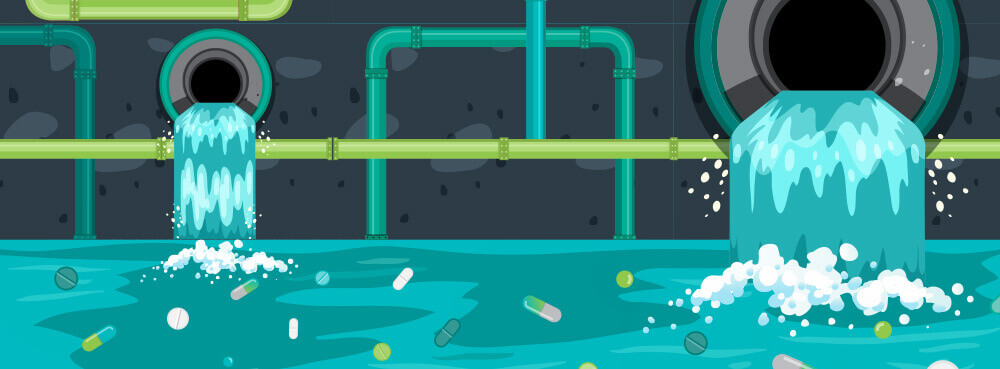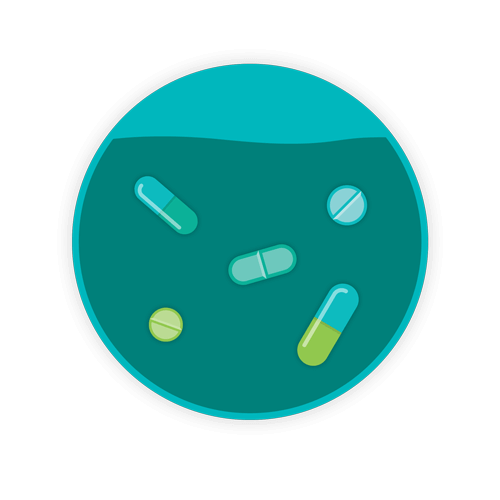How Subpart P Impacts RCRA Hazardous Pharmaceutical Waste

The new EPA Subpart P standards have taken the US healthcare industry by storm – no more disposing of pharmaceuticals in a sink. The sewer ban of RCRA hazardous waste pharmaceuticals is one of the most dramatic changes in healthcare waste regulations in this century; and is one that we all need to stop and take heed of irrespective of the role we play in drug disposal.
Effective nationally on the 21st August 2019, Subpart P regulations enacted by the Environmental Protection Agency (EPA) enforce stringent regulations on the disposal of RCRA hazardous pharmaceutical waste. (note: Subpart P does not apply to the management of non-hazardous pharmaceutical wastes, non-pharmaceutical hazardous wastes, or universal wastes). While adoption of Subpart P regulations does differ by state or authorization status, what does not change is the nationalized ban of hazardous pharmaceutical waste entering waste water via drain disposal. Whether you are a small waste producer or a large hospital generating minimal or monumental volumes of hazardous pharmaceuticals – you are immediately impacted by this regulatory change.
As a total healthcare waste partner to thousands of healthcare facilities across America, Daniels has been approached by many healthcare organizations in the last month who are confused and concerned about the new regulations’ impact on their facilities and current waste processes. We want to help you navigate this as simply as possibly so you can walk away with clear next steps of what changes you will enact to ensure the safety and compliance of your facility’s pharmaceutical waste management practices.
Subpart P Adoption
Aside from the immediate sewer ban, the effective date for Sub Part P adoption by authorized states is July 1, 2021 or July 1, 2022 if the state requires a statutory amendment. Authorized states that have adopted the new regulations as of the 16th September include Pennsylvania, New Jersey, Virginia, Kentucky, Florida, and South Dakota. A full list of the effective dates of adoption is detailed here.
Beyond dates of enforcement and state adoption remains the looming question “what has changed?” Previous EPA regulations dictated that all hazardous waste pharmaceutical generators must collect and properly manage all hazardous waste streams identified based on their facility’s hazardous waste generator status. With the new regulations, this is no longer the case – there are no generator categories under Subpart P. Subpart P regulations enforce that all SQG and LQG generators (regardless of generator status) must follow the EPA’s new regulations for the disposal of hazardous waste pharmaceuticals. This is not “in addition to”… rather this is “in place of…” existing regulations.
Operating under Subpart P without a generator status how is my healthcare facility now regulated?
- Healthcare facilities operating under Subpart P are regulated the same for their hazardous waste pharmaceuticals (no generator status determination)
- Healthcare facilities no longer have to keep track of how much hazardous waste pharmaceuticals they generate per month
- Healthcare facilities no longer have to segregate acute and non-acute hazardous waste pharmaceuticals
- Over-classification of non-hazardous pharmaceuticals incurs no risk of bumping up generator category and incurring additional regulations.
How can I be exempt from operating under Subpart P?
Quite simply, only if you are classified as a Very Small Quantity Generator (VSQG) or one of the following long term care facility types that are excluded from the Subpart P regulations:
- Group Homes
- Independent Living Communities
- Assisted Living Facilities
- Independent / Assisted living portions of continuing care retirement communities
For VSQG facilities, to achieve this status, your facility needs to generate and accumulate less hazardous waste than the following:
- Quantity of Hazardous Waste | Less than 220 lbs per month
- Acute Quantity | Less than 2.2 lbs per month
- Accumulation of Hazardous Waste | Less than 2,200 lbs
- Acute Accumulation | Less than 2.2 lbs
While VSQG’s are not subject to Subpart P, they can opt into the regulations and comply will all of its provisions or use the optional provisions of the new regulations.
How does Subpart P affect Controlled Substances?
RCRA hazardous controlled substances are exempt from RCRA regulations provided they meet the following criteria:
- Not sewered
- Managed in compliance with DEA regulations
- Destroyed by a method that the DEA has publicly deemed in writing to meet their non-retrievable standard, or…
- Combusted at a permitted facility. These include municipal waste or hazardous waste combustors, hospital, medical and infectious incinerators, commercial and industrial waste incinerators.
In addition, there are new “empty container” standards that have been ushered in, these specify that residues remaining in “RCRA empty” containers are not regulated as hazardous waste provided the dispensing bottle is smaller than 1 liter or 10,000 pills.
If Subpart P is applicable to my facility what do I do?
All generators must calculate their monthly hazardous waste totals, including hazardous waste pharmaceuticals, to determine rule applicability. If you are determined to be a small or large quantity generator, you are by law required to manage your hazardous waste pharmaceuticals under Subpart P, here are the action steps required:
01 / EPA NOTIFICATION
LQGs, SQGs and voluntary VSQGs must submit a one-time notification that they are operating under Subpart P on EPA form 8700-12 Site Identification Form. Facilities that are not required to submit a biennial report must notify within 60 days of the rule going into effect and facilities that are required to submit a biennial report may notify on their normal biennial reporting cycle
02 / DISPOSAL
Hazardous waste pharmaeuticals are no longer permitted to be disposed into a drain. This ruling applies to all healthcare facilities regardless of generator size.
03 / STAFF TRAINING
Training is required for all generators who adopt Subpart P for all personnel managing hazardous waste pharmaceuticals. Such personnel must be thoroughly familiar with proper waste handling and emergency procedures relevant to their responsibilities.
04 / CONTAINER STORAGE
The following applies wherever the container is located:
- One year limit on storage / accumulation of hazardous waste
- Accumulation containers must be labeled with the words “Hazardous Waste Pharmaceuticals”
- Containers must be structurally sound and not react with the contents
- Containers must remain closed unless adding waste, and must remain secured in a manner that prevents unauthorized access to contents
- Containers may be stored on site for 1 year from when the first item is placed in the container. Satellite accumulation standards no longer apply
05 / MANIFEST USE
Under Subpart P manifests must be used by all generators who adopt Subpart P and ship hazardous waste pharmaceuticals
06 / SHIPPING
The following applies to shipping hazardous waste pharmaceuticals:
- A uniform hazardous waste manifest and hazardous waste transporter are required for all shipments traveling to an off-site treatment facility
- Hazardous Waste Pharmaceuticals must be sent to a RCRA permitted TSDF
- EPA waste codes are no longer required on the UHWM. Instead the word “PHARMS” will be used (this is only applicable once Subpart P is in effect in both the shipping and receiving state)

Don’t take chances. Daniels Health helps you keep on top of changing regulations.
We trust this guide helps your facility navigate your hazardous waste management under the new Subpart P regulations. We will be running a webinar to train facilities further on how to action the new regulations; if you would like to sign up please enter your email in the ‘SUBSCRIBE’ button on the bottom left corner of this page and we will notify you as soon as the dates are confirmed.
Let's Talk!
Your time is valuable, and we don’t want to play hard to get. You can either phone us directly on the details listed on our contact page, or feel free to fill out this short form and one of our team members will get back to you as quickly as possible.
